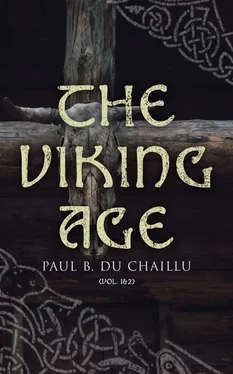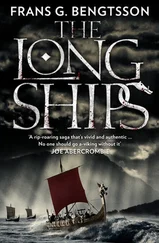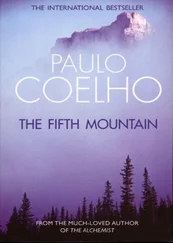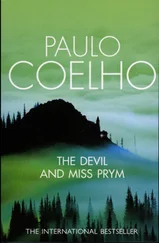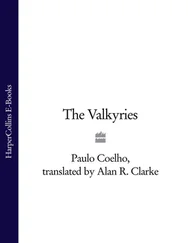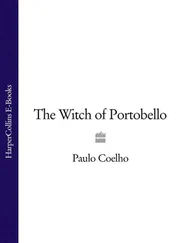There is a mythical version of the settlement of Britain contradictory of the Roman records. This version is that of Gildas whose ‘De Excidio Britanniæ’ is supposed to have been composed in the sixth century (560 A.D.), and whose statements have unfortunately been taken by one historian after the other as a true history of Britain. His narrative, which gives an account of the first arrival of the Saxons in Britain and the numerous wars which followed their invasion, has been more or less copied by Nennius, Bede and subsequent chroniclers, whose writings are a mass of glaring contradictions, diffuse and intricate, for they contain names which appear to have been invented by the writers and which cannot be traced in the language of those times, while the dates assigned for the landing of the so-called Saxons do not agree with one another.
The historians who use Gildas as an authority and try to believe his account of the settlement of Britain by Hengist and Horsa (the stallion and the mare) are obliged, in order to explain away the Roman records, to give a most extraordinary interpretation to the Notitia.
We are all aware that the people of every country like to trace their origin or history as far back as possible, and that legends often form part of the fabric of those histories. The early chroniclers, who were credulous and profoundly ignorant of the world, took these fables for facts, or they may have possibly been incorporated in the text of their supposed works after their time. The description of the settlement of a country must be founded on facts which can bear the test of searching criticism if they are to be believed and adopted; Gildas and his copyists cannot stand that test, and the Roman records, as corroborated by the archæology and literature of the North and the archæology of England, must be taken as the correct ones.
The mythological literature of the North bears evidence of a belief prevalent among the people, that their ancestors migrated at a remote period from the shores of the Black Sea, through south-western Russia, to the shores of the Baltic. This belief seems to be supported by a variety of evidence. Herodotus describes a people on the Tanais, the Budini, as being blue-eyed and yellow-haired, with houses built of wood, his description of the walls reminding one of the characteristics of the Danavirki (Herodotus, IV. 21, 108, 109). One of his tribes, the Thysagetæ , may possibly be indicated in the Thursar of the Voluspa, &c.
When we appeal to Archæology, we find in the neighbourhood of the Black Sea, near to the old Greek settlement, graves similar to those of the North, containing ornaments and other relics also remarkably like those found in the ancient graves of Scandinavia. The Runes of the North remind us strikingly of the characters of Archaic Greek. If we follow the river Dnieper upwards from its mouth in the Black Sea, we see in the museums of Kief and Smolensk many objects of types exactly similar to those found in the graves of the North. When we reach the Baltic we find on its eastern shores the Gardariki of the Sagas, where, we are told, the Odin of the North placed one of his sons, and on the southern shores many specimens have been discovered similar to those obtained in Scandinavia.
In the following chapters the reader will be struck by the similarity of the customs of the Norsemen with those of the ancient Greeks as recorded by Homer and Herodotus; for example, the horse was very much sacrificed in the North, and Herodotus, describing the Massagetæ, says:
“They (the Massagetæ) worship the sun only of all the gods, and sacrifice horses to him” (I. 216).
In regard to the Jutes, Jutland = Jöts, Jötnar; Jötland, Jötunheim, we find them from the Sagas to be a very ancient land and people, and meet several countries bearing kindred names—even to this day we have Göteborg, in which the G is pronounced as English Y .
From the Roman, Greek, Frankish, Russian, English, and Arabic records, we must come to the conclusion that the “Viking Age” lasted from about the second century of our era to about the middle of the twelfth without interruption, hence the title given to the work which deals with the history and customs of our English forefathers during that period.
CHAPTER IV.
THE MYTHOLOGY AND COSMOGONY OF THE NORSEMEN.
Table of Contents
The three poems giving the mythology and cosmogony of the North—The Völuspa, Vafthrudnismal, Grimnismal, the Asar, Jötnar, and Thursar—Odin and Vafthrudnir—The nine worlds—Before the creation—The origin of the Hrim Thursar—Birth of Ymir—Birth of Odin—Vili and Ve—The ash Yggdrasil—The well of wisdom—Hel, one of the nine worlds—The bridge Bifröst—Heimdall—Bergelmir born before the creation—The Jötun—Ymir slain by Odin—The deluge of blood—Creation of the world—Divisions of time—End of the world—A new world.
In the three poems called Völuspa , Vafthrudnismal , and Grimnismal , we have the earliest accounts of the cosmogony and of the mythology of the people of the North. The grand central figure in the mythology is Odin. He and his kin formed the people known as Asar in the lore and literature of the North, and were treated as gods. These poems are too long to be given here in full, but in the following pages we have endeavoured, by means of extracts, to give a more or less consecutive account of the subjects with which they deal.
The Völuspa was an inspired poem of a Völva or Sibyl, 20and embodies the records of the creation of the present world, and of the time prior to it; of the various races, their origin and history, and of the chaos and destruction which finally will overtake mankind.
It is in some places so obscure, that if it had not been partly explained by the later Edda, and had light thrown upon it by the sagas and ancient laws, it would be impossible to understand its meaning; and even now it is most difficult, and in some places impossible to fully comprehend several of its mythical parts, some of which will always remain enigmatical.
Vafthrudnismal is especially interesting as compared with the Völuspa, with much of which it corresponds, and some part of which it amplifies.
The mythical and the real are so intermingled that it is often impossible to distinguish the one from the other.
In the beginning we are confronted by a chief named Odin, the son of Bör, who lived near the Tanais (the river Don) not far from the Palus Mæotis (the Sea of Azof), and there we find one Asgard, which in all probability had its original in some real locality.
Besides Asar and Jötnar, many other tribes are mentioned which can hardly be regarded as altogether mythical, some of which may have inhabited the far north of the ancient Sweden, or part of the present Russia and Scandinavia; the Thursar, who were also called Hrimthursar (hoar frost), and the Risar, also Bergrisar (mountain Risar), appear from these names to have lived in a cold mountainous country, possibly the region of the Ural Mountains.
Jötunheim, the chief burgh of which was Utgard , would appear to be a general, vague name given to a very wide extent of country not embraced in Asaheim (the home of the Asar). Jötunheim, as the name indicates, was the home or country of the Jötnar and Thursar, between whom and the Asar there was fierce enmity.
Some of the Jötnar were considered very wise, and Odin, as the chief of the Asar, determined to go in disguise to Jötunheim, the home of the Jötnar, in order to seek out the Jötun Vafthrudnir 21(the mighty or wise in riddles), who was renowned for his knowledge. The song begins by representing Odin as consulting his wife, Frigg, as to the advisability of undertaking the journey. The stanzas which follow represent Odin questioning Vafthrudnir in his search for knowledge:—
Читать дальше
